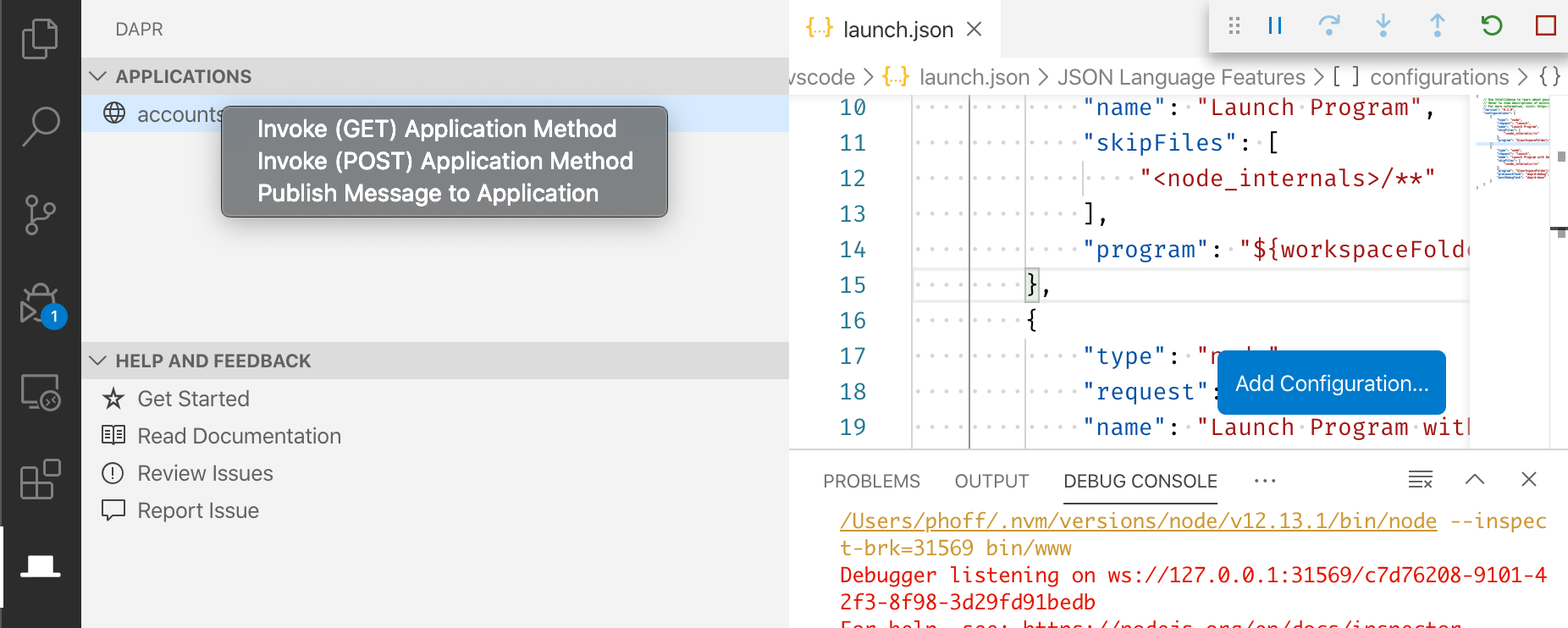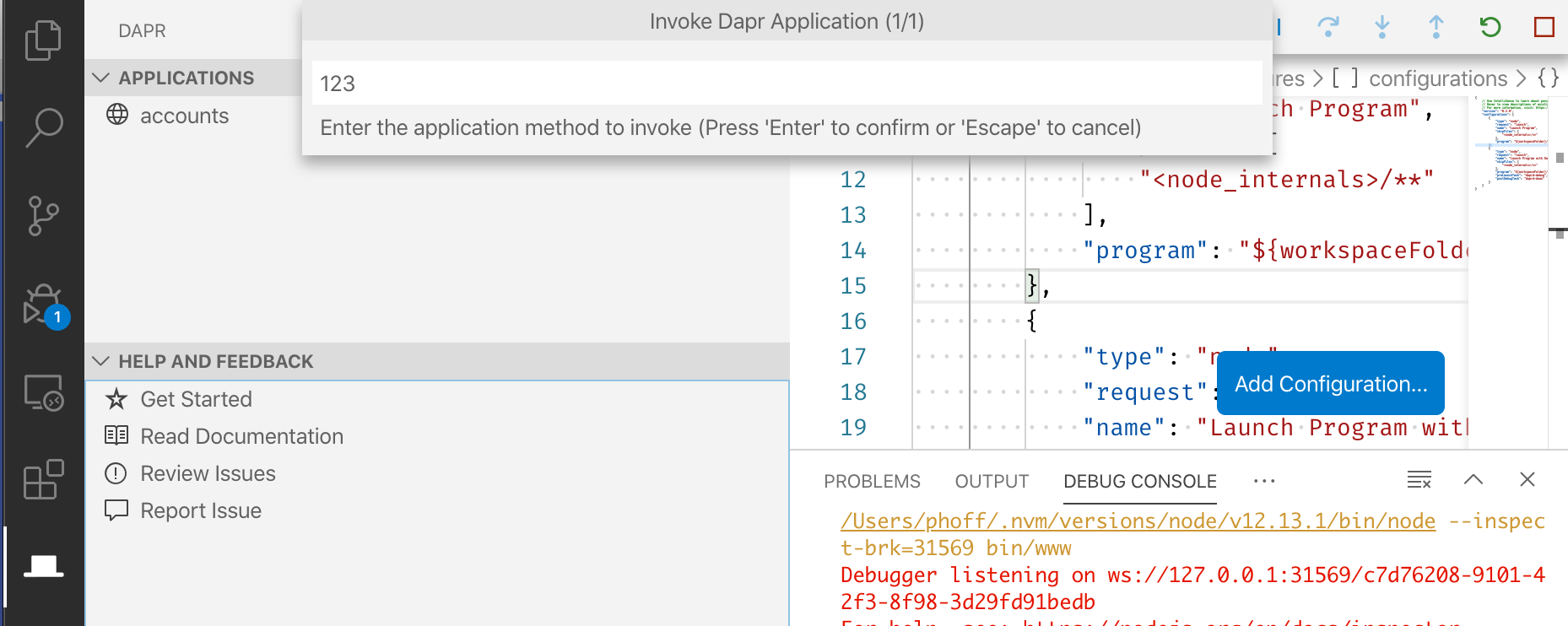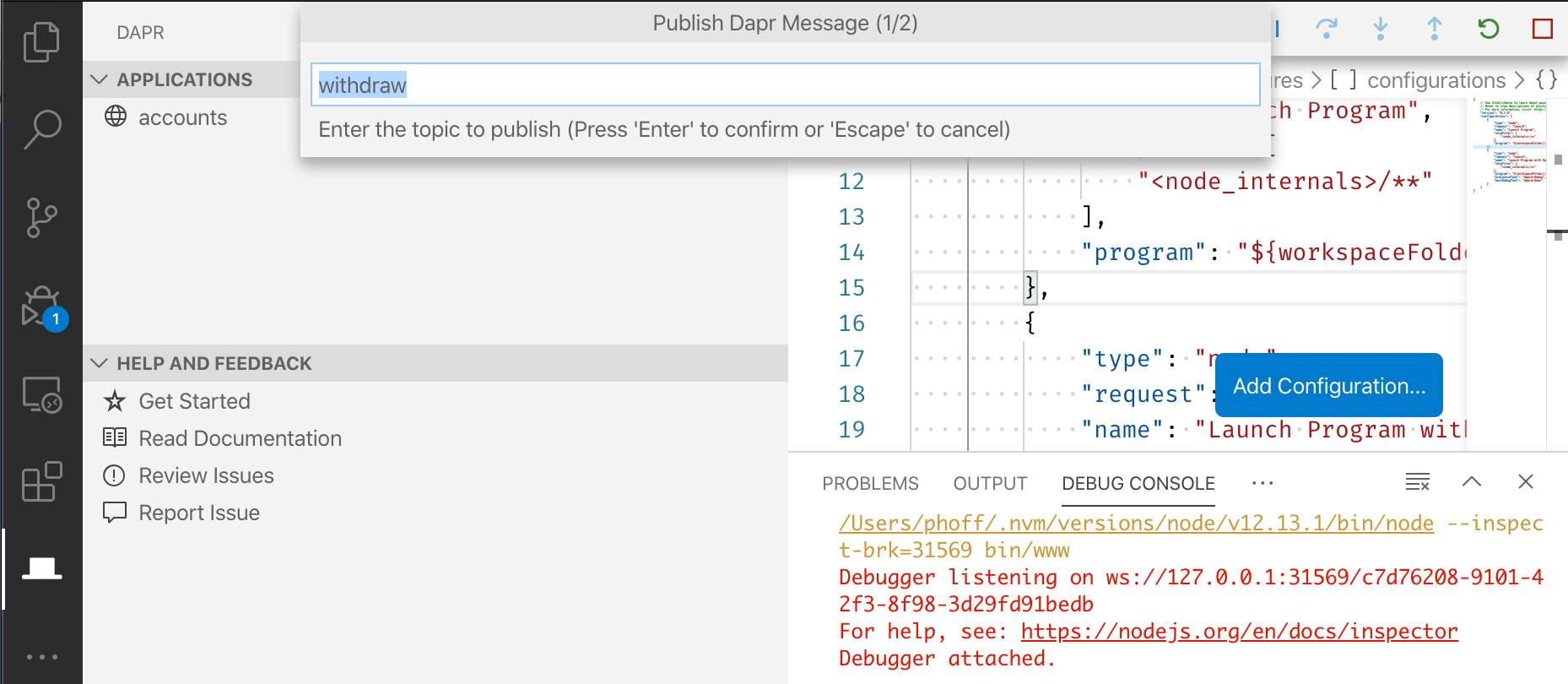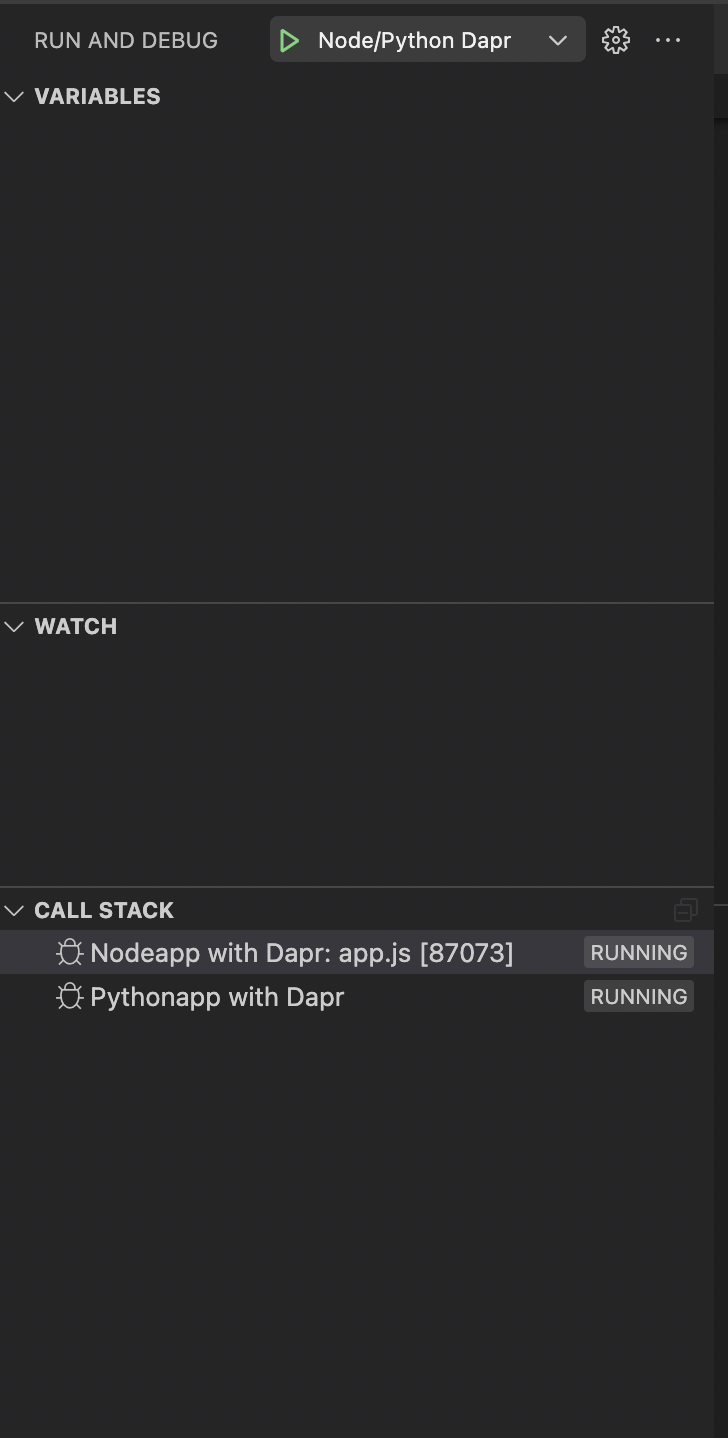This is the multi-page printable view of this section. Click here to print.
Visual Studio Code integration with Dapr
- 1: Dapr Visual Studio Code extension overview
- 2: How-To: Debug Dapr applications with Visual Studio Code
- 3: Developing Dapr applications with Dev Containers
1 - Dapr Visual Studio Code extension overview
Dapr offers a preview Dapr Visual Studio Code extension for local development which enables users a variety of features related to better managing their Dapr applications and debugging of your Dapr applications for all supported Dapr languages which are .NET, Go, PHP, Python and Java.
Features
Scaffold Dapr debugging tasks
The Dapr extension helps you debug your applications with Dapr using Visual Studio Code’s built-in debugging capability.
Using the Dapr: Scaffold Dapr Tasks Command Palette operation, you can update your existing task.json and launch.json files to launch and configure the Dapr sidecar when you begin debugging.
- Make sure you have a launch configuration set for your app. (Learn more)
- Open the Command Palette with
Ctrl+Shift+P - Select
Dapr: Scaffold Dapr Tasks - Run your app and the Dapr sidecar with
F5or via the Run view.
Scaffold Dapr components
When adding Dapr to your application, you may want to have a dedicated components directory, separate from the default components initialized as part of dapr init.
To create a dedicated components folder with the default statestore, pubsub, and zipkin components, use the Dapr: Scaffold Dapr Components Command Palette operation.
- Open your application directory in Visual Studio Code
- Open the Command Palette with
Ctrl+Shift+P - Select
Dapr: Scaffold Dapr Components - Run your application with
dapr run --resources-path ./components -- ...
View running Dapr applications
The Applications view shows Dapr applications running locally on your machine.

Invoke Dapr applications
Within the Applications view, users can right-click and invoke Dapr apps via GET or POST methods, optionally specifying a payload.

Publish events to Dapr applications
Within the Applications view, users can right-click and publish messages to a running Dapr application, specifying the topic and payload.
Users can also publish messages to all running applications.

Additional resources
Debugging multiple Dapr applications at the same time
Using the VS Code extension, you can debug multiple Dapr applications at the same time with Multi-target debugging.
Community call demo
Watch this video on how to use the Dapr VS Code extension:
2 - How-To: Debug Dapr applications with Visual Studio Code
Manual debugging
When developing Dapr applications, you typically use the Dapr CLI to start your daprized service similar to this:
dapr run --app-id nodeapp --app-port 3000 --dapr-http-port 3500 app.js
One approach to attaching the debugger to your service is to first run daprd with the correct arguments from the command line and then launch your code and attach the debugger. While this is a perfectly acceptable solution, it does require a few extra steps and some instruction to developers who might want to clone your repo and hit the “play” button to begin debugging.
If your application is a collection of microservices, each with a Dapr sidecar, it will be useful to debug them together in Visual Studio Code. This page will use the hello world quickstart to showcase how to configure VSCode to debug multiple Dapr application using VSCode debugging.
Prerequisites
- Install the Dapr extension. You will be using the tasks it offers later on.
- Optionally clone the hello world quickstart
Step 1: Configure launch.json
The file .vscode/launch.json contains launch configurations for a VS Code debug run. This file defines what will launch and how it is configured when the user begins debugging. Configurations are available for each programming language in the Visual Studio Code marketplace.
Scaffold debugging configuration
The Dapr VSCode extension offers built-in scaffolding to generate launch.json and tasks.json for you.
In the case of the hello world quickstart, two applications are launched, each with its own Dapr sidecar. One is written in Node.JS, and the other in Python. You’ll notice each configuration contains a daprd run preLaunchTask and a daprd stop postDebugTask.
{
"version": "0.2.0",
"configurations": [
{
"type": "pwa-node",
"request": "launch",
"name": "Nodeapp with Dapr",
"skipFiles": [
"<node_internals>/**"
],
"program": "${workspaceFolder}/node/app.js",
"preLaunchTask": "daprd-debug-node",
"postDebugTask": "daprd-down-node"
},
{
"type": "python",
"request": "launch",
"name": "Pythonapp with Dapr",
"program": "${workspaceFolder}/python/app.py",
"console": "integratedTerminal",
"preLaunchTask": "daprd-debug-python",
"postDebugTask": "daprd-down-python"
}
]
}
If you’re using ports other than the default ports baked into the code, set the DAPR_HTTP_PORT and DAPR_GRPC_PORT environment variables in the launch.json debug configuration. Match with the httpPort and grpcPort in the daprd tasks.json. For example, launch.json:
{
// Set the non-default HTTP and gRPC ports
"env": {
"DAPR_HTTP_PORT": "3502",
"DAPR_GRPC_PORT": "50002"
},
}
tasks.json:
{
// Match with ports set in launch.json
"httpPort": 3502,
"grpcPort": 50002
}
Each configuration requires a request, type and name. These parameters help VSCode identify the task configurations in the .vscode/tasks.json files.
typedefines the language used. Depending on the language, it might require an extension found in the marketplace, such as the Python Extension.nameis a unique name for the configuration. This is used for compound configurations when calling multiple configurations in your project.${workspaceFolder}is a VS Code variable reference. This is the path to the workspace opened in VS Code.- The
preLaunchTaskandpostDebugTaskparameters refer to the program configurations run before and after launching the application. See step 2 on how to configure these.
For more information on VSCode debugging parameters see VS Code launch attributes.
Step 2: Configure tasks.json
For each task defined in .vscode/launch.json , a corresponding task definition must exist in .vscode/tasks.json.
For the quickstart, each service needs a task to launch a Dapr sidecar with the daprd type, and a task to stop the sidecar with daprd-down. The parameters appId, httpPort, metricsPort, label and type are required. Additional optional parameters are available, see the reference table here.
{
"version": "2.0.0",
"tasks": [
{
"label": "daprd-debug-node",
"type": "daprd",
"appId": "nodeapp",
"appPort": 3000,
"httpPort": 3500,
"metricsPort": 9090
},
{
"label": "daprd-down-node",
"type": "daprd-down",
"appId": "nodeapp"
},
{
"label": "daprd-debug-python",
"type": "daprd",
"appId": "pythonapp",
"httpPort": 53109,
"grpcPort": 53317,
"metricsPort": 9091
},
{
"label": "daprd-down-python",
"type": "daprd-down",
"appId": "pythonapp"
}
]
}
Step 3: Configure a compound launch in launch.json
A compound launch configuration can defined in .vscode/launch.json and is a set of two or more launch configurations that are launched in parallel. Optionally, a preLaunchTask can be specified and run before the individual debug sessions are started.
For this example the compound configuration is:
{
"version": "2.0.0",
"configurations": [...],
"compounds": [
{
"name": "Node/Python Dapr",
"configurations": ["Nodeapp with Dapr","Pythonapp with Dapr"]
}
]
}
Step 4: Launch your debugging session
You can now run the applications in debug mode by finding the compound command name you have defined in the previous step in the VS Code debugger:

You are now debugging multiple applications with Dapr!
Daprd parameter table
Below are the supported parameters for VS Code tasks. These parameters are equivalent to daprd arguments as detailed in this reference:
| Parameter | Description | Required | Example |
|---|---|---|---|
allowedOrigins |
Allowed HTTP origins (default “*”) | No | "allowedOrigins": "*" |
appId |
The unique ID of the application. Used for service discovery, state encapsulation and the pub/sub consumer ID | Yes | "appId": "divideapp" |
appMaxConcurrency |
Limit the concurrency of your application. A valid value is any number larger than 0 | No | "appMaxConcurrency": -1 |
appPort |
This parameter tells Dapr which port your application is listening on | Yes | "appPort": 4000 |
appProtocol |
Tells Dapr which protocol your application is using. Valid options are http, grpc, https, grpcs, h2c. Default is http. |
No | "appProtocol": "http" |
args |
Sets a list of arguments to pass on to the Dapr app | No | “args”: [] |
componentsPath |
Path for components directory. If empty, components will not be loaded. | No | "componentsPath": "./components" |
config |
Tells Dapr which Configuration resource to use | No | "config": "./config" |
controlPlaneAddress |
Address for a Dapr control plane | No | "controlPlaneAddress": "http://localhost:1366/" |
enableProfiling |
Enable profiling | No | "enableProfiling": false |
enableMtls |
Enables automatic mTLS for daprd to daprd communication channels | No | "enableMtls": false |
grpcPort |
gRPC port for the Dapr API to listen on (default “50001”) | Yes, if multiple apps | "grpcPort": 50004 |
httpPort |
The HTTP port for the Dapr API | Yes | "httpPort": 3502 |
internalGrpcPort |
gRPC port for the Dapr Internal API to listen on | No | "internalGrpcPort": 50001 |
logAsJson |
Setting this parameter to true outputs logs in JSON format. Default is false | No | "logAsJson": false |
logLevel |
Sets the log level for the Dapr sidecar. Allowed values are debug, info, warn, error. Default is info | No | "logLevel": "debug" |
metricsPort |
Sets the port for the sidecar metrics server. Default is 9090 | Yes, if multiple apps | "metricsPort": 9093 |
mode |
Runtime mode for Dapr (default “standalone”) | No | "mode": "standalone" |
placementHostAddress |
Addresses for Dapr Actor Placement servers | No | "placementHostAddress": "http://localhost:1313/" |
profilePort |
The port for the profile server (default “7777”) | No | "profilePort": 7777 |
sentryAddress |
Address for the Sentry CA service | No | "sentryAddress": "http://localhost:1345/" |
type |
Tells VS Code it will be a daprd task type | Yes | "type": "daprd" |
Related Links
3 - Developing Dapr applications with Dev Containers
The Visual Studio Code Dev Containers extension lets you use a self-contained Docker container as a complete development environment, without installing any additional packages, libraries, or utilities in your local filesystem.
Dapr has pre-built Dev Containers for C# and JavaScript/TypeScript; you can pick the one of your choice for a ready made environment. Note these pre-built containers automatically update to the latest Dapr release.
We also publish a Dev Container feature that installs the Dapr CLI inside any Dev Container.
Setup the development environment
Prerequisites
Add the Dapr CLI using a Dev Container feature
You can install the Dapr CLI inside any Dev Container using Dev Container features.
To do that, edit your devcontainer.json and add two objects in the "features" section:
"features": {
// Install the Dapr CLI
"ghcr.io/dapr/cli/dapr-cli:0": {},
// Enable Docker (via Docker-in-Docker)
"ghcr.io/devcontainers/features/docker-in-docker:2": {},
// Alternatively, use Docker-outside-of-Docker (uses Docker in the host)
//"ghcr.io/devcontainers/features/docker-outside-of-docker:1": {},
}
After saving the JSON file and (re-)building the container that hosts your development environment, you will have the Dapr CLI (and Docker) available, and can install Dapr by running this command in the container:
dapr init
Example: create a Java Dev Container for Dapr
This is an example of creating a Dev Container for creating Java apps that use Dapr, based on the official Java 17 Dev Container image.
Place this in a file called .devcontainer/devcontainer.json in your project:
// For format details, see https://aka.ms/devcontainer.json. For config options, see the
// README at: https://github.com/devcontainers/templates/tree/main/src/java
{
"name": "Java",
// Or use a Dockerfile or Docker Compose file. More info: https://containers.dev/guide/dockerfile
"image": "mcr.microsoft.com/devcontainers/java:0-17",
"features": {
"ghcr.io/devcontainers/features/java:1": {
"version": "none",
"installMaven": "false",
"installGradle": "false"
},
// Install the Dapr CLI
"ghcr.io/dapr/cli/dapr-cli:0": {},
// Enable Docker (via Docker-in-Docker)
"ghcr.io/devcontainers/features/docker-in-docker:2": {},
// Alternatively, use Docker-outside-of-Docker (uses Docker in the host)
//"ghcr.io/devcontainers/features/docker-outside-of-docker:1": {},
}
// Use 'forwardPorts' to make a list of ports inside the container available locally.
// "forwardPorts": [],
// Use 'postCreateCommand' to run commands after the container is created.
// "postCreateCommand": "java -version",
// Configure tool-specific properties.
// "customizations": {},
// Uncomment to connect as root instead. More info: https://aka.ms/dev-containers-non-root.
// "remoteUser": "root"
}
Then, using the VS Code command palette (CTRL + SHIFT + P or CMD + SHIFT + P on Mac), select Dev Containers: Rebuild and Reopen in Container.
Use a pre-built Dev Container (C# and JavaScript/TypeScript)
- Open your application workspace in VS Code
- In the command command palette (
CTRL + SHIFT + PorCMD + SHIFT + Pon Mac) type and selectDev Containers: Add Development Container Configuration Files...
- Type
daprto filter the list to available Dapr remote containers and choose the language container that matches your application. Note you may need to selectShow All Definitions...
- Follow the prompts to reopen your workspace in the container.

Example
Watch this video on how to use the Dapr Dev Containers with your application.